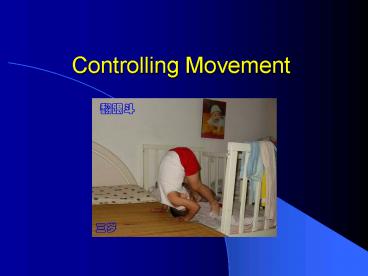Controlling Movement PowerPoint PPT Presentation
Title: Controlling Movement
1
Controlling Movement
2
Underlying Questions
- What is being controlled?
- How is movement controlled?
- What beliefs exist to explain this control?
3
Degrees of Freedom
- Number of ways independent components
of a system can act - Motor units
- Muscles
- Joints
- How does the nervous system control the many
muscles and joints involved in producing a given
pattern? How does it solve this degrees-of-
freedom problem?
4
Coordination
- The process by which an individual condenses the
available degrees-of-freedom - Movement patterns
constrained by
characteristics of the
environment
5
Control Mechanisms
- Closed-Loop
commands
control center
effectors
comparator
feedback
6
Closed-Loop Control
- Involves use of feedback and error detection
correction to maintain desired goal - Type of skills (classification)?
- Examples?
- Driving a Car!
7
Control Mechanisms
- Open-Loop
commands
effectors
control center
8
Open-Loop Control
- Use of centrally determined, prestructured
commands sent to effectors and run off without
use of feedback - Type of skills (classification)?
- Examples?
9
Open-Loop vs. Closed-Loop Control
- What factors determine which control system is
employed?
Skill level
Duration of movement
10
Control Explanations
- Information Processing
Input
Perception
Decision Making
Execution
Output
Feedback
11
Information Processing Model
- Movement planning execution are responsibility
of cortical command centers - Movements stored in
form of Generalized
Motor Program (GMP)
12
Generalized Motor Program
- Abstract representation of stored pattern for
class of action - Prestructured set of movement commands
- Invariant features stored
- Particular muscles needed to produce action
- Order of muscle activation
- Relative timing sequencing of contractions
- Relative force of various muscle contractions
- Organizes many df into single unit for efficient
and effective action
13
GMP
- Accounts for performance of movements in absence
of feedback - Movements in different
contexts - Novel movements are possible
- HOW?
14
GMP Parameters
- Parameters - modifiable features of GMP
- Variations in movement
time - Variations in movement
amplitude - Variations in limb muscles
used
15
Control Explanations
- Dynamic Systems
Action
Perception
16
Dynamic Systems
- Planning of actions does not require elaborate
cognitive processing - Motor behavior emerges from interaction of
multiple subsystems - Actions shaped by intention of performer
and constraints of environment

